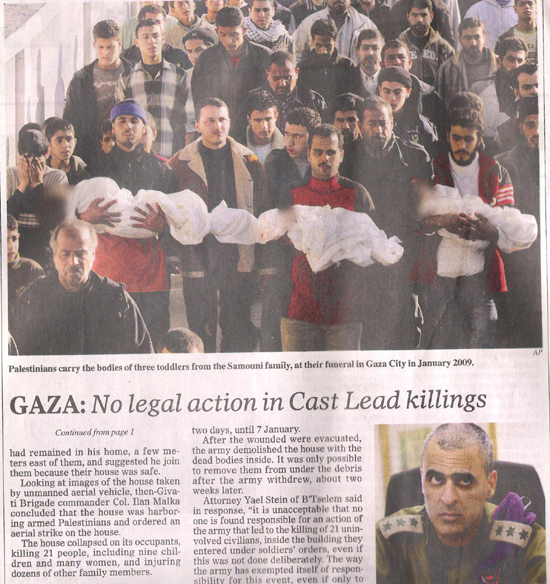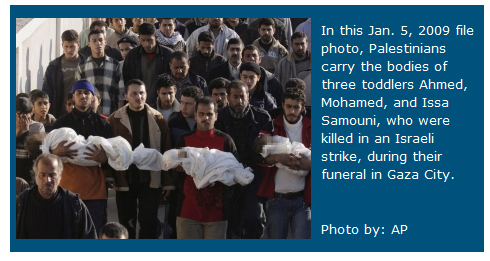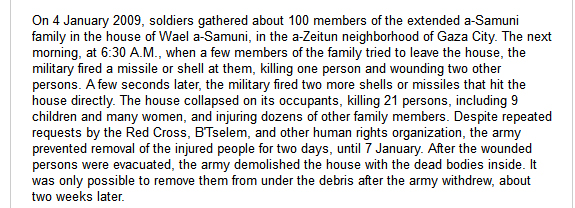May 2 — Ha’aretz journalist Amira Hass has probably written more than any other reporter on the killings of members of the extended Samouni family of al-Zaytoun in an air strike on their home during fighting in Gaza that took place in January 2009. It was a complicated case mired by innumerable contradictions and inconsistencies. There were different accounts given in media reports, NGOs and the Goldstone Report, where names and ages of the victims don’t match up. There are also varying statistics on how many were killed; disparate accounts about who left the house and why; contradictory stories about whether certain members of the family were killed by soldiers firing at them point blank or in an air strike; and largely ignored information disputing the oft-reported claim that all those killed were civilians.
And yet, as detailed in an earlier CAMERA article, Amira Hass
does little in the way of original research, instead parroting the Samouni family’s claims, even when they are self-contradictory. She also ignores evidence that Palestinian fighters were active in the neighborhood at the time of the incidents, that at least a couple members of the clan were members of the Palestinian Islamic Jihad and that there possibly had been shooting from the Samouni home.
Hass’ latest article today in Ha’aretz, based on a new B’Tselem press release blasting the Israeli army’s decision to close the investigation, delivers up more of the same—including inconsistencies even with her own earlier reports, as well as other open-source information about the deaths, such as media reports from the time of the incident. A typical and yet particularly graphic example of the countless contradictory facts is encapsulated in Hass’ claim, lifted from the B’Tselem release, that:
After the wounded were evacuated, the army demolished the house with the dead bodies inside. It was only possible to remove them from under the debris after the army withdrew, about two weeks later.
The print edition of the article is accompanied by the following Associated Press photograph:

According to B’Tselem and Hass, the bodies of the Samouni family were removed from the demolished house “after the army withdrew, about two weeks later.” Based on this assertion, the photograph depicting the funeral for three Samouni children would have been taken around Jan. 19, 2009. But that is not at all the case. According to the original caption from the AP photograph by Hatem Moussa, the funeral took place on Jan. 5, the very day that the children died. The AP’s caption reads:
Palestinians carry the bodies of three toddlers Ahmed, Mohamed, and Issa Samouni, who according to Palestinian medical sources were killed in an Israeli strike, during their funeral in Gaza City, Monday, Jan. 5, 2009. Israel forces pounded Gaza Strip houses, mosques and smuggling tunnels on Monday from the air, land and seak, killing at least seven children as they pressed a bruising offensive against Palestinian militants.
Indeed, the online edition of the Ha’aretz story does give the correct date of the funeral, Jan. 5:

Therein lies a quandary that is typical of the Samouni story: on the one hand, Ha’aretz claims the bodies were removed from the site only two weeks later, after mid-January. On the other hand, Ha’aretz features a photograph of the bodies of three small victims at their Jan. 5 funeral.
Yvonne Green, a British poet who visited the Samounis after the inciden, hit the nail on the head when she wrote in the Jerusalem Post:
I was told stories at Samouni Street which contradicted each other, what I saw and later media accounts. Examples of these inconsistencies are that 24, 31, 34 or more members of the Fatah Samouni family had died. That all the deaths occurred when Israel bombed the safe building it had told 160 family members to shelter in; the safe building was pointed out to me but looked externally intact and washing was still hanging on a line on one of its balconies. That some left the safe building and were shot in another house.
That there was no resistance — but the top right hand window of the safe building (which appears in a BBC Panorama film “Out of the Ruins” aired February 8) has a black mark above it — a sign I was shown all day of weaponry having been fired from inside. That victims were left bleeding for two or three days.
I saw large scoured craters and a buckled container which appeared to have been damaged by an internal impact (its external surfaces were undamaged). Media accounts of Samouni Street don’t mention these possible indications of explosive caches (although the container is visible on media footage). The Samouni family’s elder told me during a taped interview that he has a CD film of the killings. As far as I’m aware, no such film has been made public. . . .
In short, as the journalist who has written the most on the Samouni incident, Hass has done nothing to resolve the many discrepancies. Instead, she adds to them: Her own writing is shamelessly rife with inconsistencies. There is, however, one point of consistency in this whole saga: Hass routinely accepts any testimony presented to her by Palestinians as fact, even when she has to ignore their own self-contradictions. Yesterday, too, brought us just such an example.
and writing out the word “nine,” instead of using the numerical 9.) Hass reported:
The house collapsed on its occupants, killing 21 people, including nine children and many women, and injuring dozens of other family members. Despite repeated requests by the Red Cross, B’Tselem, and other human rights organizations, the army prevented removal of the injured people for two days, until 7 January. After the wounded were evacuated, the army demolished the house with the dead bodies inside. It was only possible to remove them from under the debris after the army withdrew, about two weeks later.
Here is the text as it appears in the B’Tselem press release, identical to the Ha’aretz story:

Moreover, in the wake of this May 2 critique, Ha’aretz quietly changed this key (plagiarized) passage, simply removing the claim that the army demolished the home on the bodies, and that the bodies were trapped inside for two weeks. It is still possible to read the cached version of the original article online. Here is the text which now appears online instead of the factually-challenged material plagiarized from B’Tselem:
Some of the casualties were trapped in the destroyed house, among the bodies, for three days, until the IDF allowed rescue services to arrive at the house and evacuate the bodies.
That wasn’t the only passage that quietly got a makeover online. In a separate scrubbing, the print edition and the original Web article had stated:
Looking at images of the house taken by unmanned aerial vehicle, then -Givati Brigade commander Col. Ilan Malka concluded that the house was harboring armed Palestinians and ordered an aerial strike on the house.
In the updated version, this information is attributed to “testimonies given to Haaretz and Breaking the Silence by soldiers who took part in the attack.”
In short, there are multiple serious journalistic problems with Hass’ May 2 article:
1) The claim that the army prevented removal of the bodies for two weeks, despite an AP photograph showing otherwise.
2) The problematic claim is contained in a passage plagiarized, virtually word for word, from B’Tselem.
3) The subsequent quiet scrubbing of the factually-challenged, plagiarized passage from the Ha’aretz Web site without admission of any wrongdoing.
